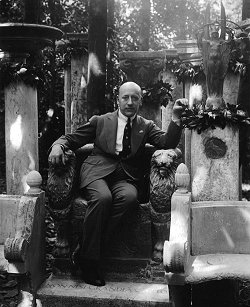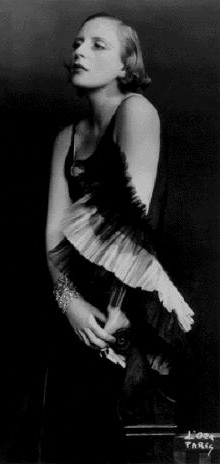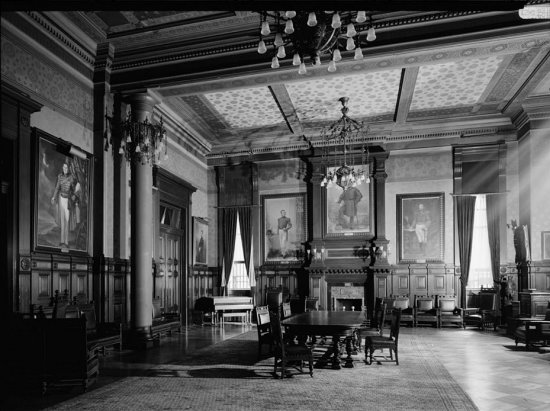Following characters from room to room and choosing which scenes to watch and which to miss might seem rather hard work for an audience. But New Yorkers who go and see Tamara (soon to come to London) are swept up in this new drama of interaction — so much more gratifying than tedious old alienation. Andrew Solomon describes what it is like to spy on D’Annunzio’s weekend party.

Self-Portrait in the Green Bugatti, Tamara de Lempicka, 1925. Source: Wikimedia Commons.
“You are expected, Mr. Solomon,” a manservant said after consulting a long and much-annotated list. “Here is your passport. Please proceed to immigration.” He pointed toward a narrow passage and a high desk at which an official in military dress glowered meaningfully. “Behave yourself with caution once you have cleared customs,” the man counselled me. “Remember that you are in a Fascist zone.”
I was in the Seventh Regiment Armoury on the corner of Park Avenue and 67th Street in New York, a spot I had previously entered only for antique shows, tennis games, occasional balls, and the 1978 Victorian Society Scholarship Fund Tea Dance, a memorable event at which Gloria Vanderbilt lost a diamond earring and Fran Lebowitz found it. All such festivities have given way, however, to the newest event in New York, which is Tamara, an opulent theatre piece that brings together a fascinating script and some very good actors, food by Daniel Boulud from Le Cirque, costume designs by Italian couturier Gianfranco Ferre, and the architectural beauties of the Armoury.
Tamara is part play, part soap opera, and part party. At the moment tickets are virtually unobtainable despite their rather forbidding price of $135. At first they were unobtainable because really everyone had to see Tamara. Now they are unobtainable because really everyone has to see Tamara twice, or three times, or perhaps four. And there are only about 150 people admitted each evening to experience the piece in all its glory. The producers hope to open a London production of Tamara within the next two years, and are currently negotiating for Chiswick House; the production is so elaborate that they expect to spend more than a year preparing it.
The idea is that Gabriele D’Annunzio is having a weekend party in Il Vittoriale, the fabulous castle in which Mussolini incarcerated him to prevent his intervention in the Second World War. D’Annunzio has invited the beautiful expatriate Polish painter Tamara de Lempicka to paint his portrait, but he is more interested in her seduction than in her paintings, and she arrives from Paris to find a web of sexual and political intrigue.

Gabriele D’Annunzio
The house is spectacularly beautiful, but is peopled by a weird cast: it includes d’Annunzio’s ex-mistress, Luisa Baccara; Gian Francesco de Spiga, a sinisterly charming dilettante; Aelis Mazoyer, the lesbian who runs d’Annunzio’s house and helps him in his ploys to seduce visitors; Mario, the handsome and mysterious chauffeur; Finzi, a Jew and a Fascist policeman; and Emilia, d’Annunzio’s vivacious maid and sometime mistress.
The audience are guests of a different order at this party. Upon arrival, each audience member presents himself to collect his passport-cum-programme, in which his name is inscribed, and which is given without any of the messy vulgarity of presenting charge-cards or signing papers. He is then rushed past customs, into the grand entrance hall of the Armoury, where a double staircase, richly draped with silks to create the atmosphere of Il Vittoriale, curves around a hall as spectacular as any in New York.
There is already action afoot: behind a column, the maid and the chauffeur are kissing one another, and the Fascist guard Finzi marches up and down, reminding everyone to stay in order and suggesting strongly that everyone read the laws, inscribed in his passport. “Above all,” he reiterates, “do not lose your passport.” The members of the audience spend this initial period looking at one another and they are well worth looking at. Everyone runs into old school friends and other unlikely acquaintances. Blonde women in Lacroix couture and diamonds are commonplace. Despite the warnings in all the reviews that Tamara entails a lot of walking and that anyone who goes to see it should wear sneakers and old clothes, everyone is dressed to the nines, the men in smart suits they have worn from their smart offices, the women in elegant couture of the sort hardly ever seen at the theatre in New York, and only occasionally at the opera.

Seventh Regiment Armory Veterans Room, designed by Louis Comfort Tiffany. Photo: Jack E. Boucher, Historic American Buildings Survey, 1984. Source: Library of Congress.
The front part of the Armoury includes the spectacular Tiffany rooms, and the play takes place in these and in the adjoining rooms, both upstairs and downstairs. The rooms have been refilled, refurbished, and refurnished opulently. The whole villa has been re-created, and the idea is that the characters go about their lives as if there were no audience. At any given time there are several scenes going on at once in several various rooms. As an audience member you are permitted to follow any character you like for the whole play, or to follow one character into a room and another character out of the room. You are not permitted to wander from room to room except in the wake of one of the characters. So you are constantly making choices. At the end of the dramatic confrontation between Tamara and Mario, the chauffeur, you may choose to follow Mario out of the room, or you may prefer to stay with Tamara in the bedroom in which d’Annunzio, set on her seduction, has left a Fortuny dress and spectacular pieces of jewellery. At the end of a tumultuous scene in the oratorio, you may follow any of a half-dozen characters as one after the other they storm out.
Wise people go to Tamara in groups and agree to split up. “I’ll follow her, and you follow him, and why don’t you follow that Aelis woman, and then if Elizabeth follows the maid, we should be able to put together whatever we missed last time,” people arrange as they stand drinking champagne before the play begins. “We’ll meet at the interval and compare notes.” And of course the negotiations become involved: “I followed the ballerina last time, and tonight I want to follow Tamara. Why doesn’t Michael follow the chauffeur?” But Michael has never come before and does not want to spend the evening following one of the servants. “I’ll follow Finzi, the policeman,” he volunteers. Someone not of their party leans over and says knowingly, “You’ll have a more interesting time following the chauffeur,” and Michael is subdued.
At the interval everyone compares notes during a buffet supper of stupefying dimensions. It is set up in the dining-room — where only moments before some of the audience watched some of the play’s characters eating dessert — and the audience members sit on the chairs and benches that are part of the set, or sprawl on the plinth of d’Annunzio’s statue, or curl up on one of the pillows Tamara flung in irritation to the floor.

Tamara de Lempicka. Photo by Dora Kallmus of d’Ora Studio, Paris, 1929. Source: Wikimedia Commons.
Throughout the interval constant gasps greet hundreds of little corrections. “Did she say that? And the policeman heard her? But she’s in love with him!”
“I don’t think that’s right. She’s actually in love with the other one. I think she’s just pretending to love him for the sake of the other one, who might be in danger.”
“No, I’m sure, because she was betraying the other one the whole time, when I was in the servants’ quarters, and she told him that the other one was going to leave.”
“You follow him next half, and I’ll follow her.”
The audience, people self-sufficient enough so that they would never dream of striking up conversations with strangers at an ordinary play, join one another and form large groups while they stand on the buffet line. “You were in the bedroom with me, weren’t you, just after she got the dress? That one who came in, he was saying that he was part of the underground, wasn’t he?”
“Yes, I think so, but what happened to her after that? I followed him, and I just got a useless love scene with the maid.”
“She had a long monologue and then she put on the dress and went out to meet d’Annunzio. You didn’t miss too much there.”
The story of Tamara has a strong element of the soap opera in it. Everyone is having an affair with someone, and everyone seems to have designs on someone else. Some are in love. All are Fascist or anti-Fascist, but there are constant confusions about who is which. The choices you make as you follow the audience through are difficult ones; is it better to follow Emilia, the maid, who is a brilliant actress, and who has some of the best lines in the play? Or to follow a character who is less fun to watch but who may hold the key to an unexplained mystery that emerged several scenes earlier? This is a production in which every kind of art activity goes on, and it’s fascinating to watch Tamara draw, or to listen to Luisa play the piano, or to watch Carlotta dance. Some of the scenes are rather moving; some are dramatic; at one point, Tamara’s life is threatened as one character almost strangles her, and as a member of the audience you are close enough to smell the perfume and sweat of the actress as the chain draws closer around her neck.
It is interesting that Tamara is a grand event more than an avant-garde theatre piece; at the moment, there is another “interactive” play in New York, Tony ‘n’ Tina’s Wedding, in which the audience attends a wedding ceremony at Washington Square Church and then follows the cast to the reception, at Carmelita’s Restaurant, at which they eat the wedding food and dance to the wedding band and continue to observe Tina and Tony and their families just as though they were real guests at a real wedding. This play has been billed as a new experiment in theatre, and the artiest of the arty are downtown to see it. Tamara does itself a disservice by distracting its audience form its wit and its originality by means of its magnificence. The play is actually very clever, constructed so that every experience of it is complete, so that every piece of knowledge is interesting by itself and is also a clue to some larger puzzle.

Luisa Baccara, ca. 1925.
The precision required to prevent the scenes from overlapping at the wrong moments is also most impressive; when one character storms out of one room and into another, he mustn’t be early or late, or the scenes will lose their meaning. There is always a great appeal to melodramas, and this one weaves together all that one likes best, and plays on the emotions in turn. The finest performances, like Lally Cadeau‘s poignant portrayal of Luisa Baccara, or Roma Downey‘s charming Emilia, are all the more mesmerising because of the intimacy with which they are experienced. It is very odd to have uninformed control over your experience of the play, licence to make endless decisions without knowing where they will lead, and to have the intensity of focus bred of physical proximity to the characters; but what is most disturbing is that despite this fantasy of involvement, the audience members have no ability to change the action of the play at all. Indeed they are in much the same position as d’Annunzio, the semi-resigned semi-prisoner of Mussolini, able to think as he chooses so long as he does nothing. The connection between the form and the subject-matter has a certain brilliance; our experience is necessarily one of empathy.
At the end of the play there is a fabulously dramatic scene in which everyone at last comes together in one place. All the tangled threads are untied. A shot is fired. And then there is pudding — again from Le Cirque, and for some, the best part of the evening, featuring the same chocolate cake which had looked so tempting when Tamara ate it in the dining-room. Everyone is determined to come again (the price is lower after your third visit) to see the scenes other people are describing. “I saw a whole different play tonight than I did last time,” one tall man says to his wife.
“I want to see some of those scenes you followed,” she replies. “And I want to follow that Gian Francesco de Spiga and find out what his role really is. Let’s come back and bring the Westerbrooks. They’d love it.
An elegant woman of great beauty gazes sadly at the rest of the audience, which is beginning to disperse. “It’s like a party for two hundred of my best friends whom I don’t even know. And now it’s over.” She pauses dolefully. Then her face brightens. “Maybe some of them will be here next time.”

Seventh Regiment Armory First Floor Clark Room. Photo: Jack E. Boucher, Historic American Buildings Survey, 1984. Source: Library of Congress.











